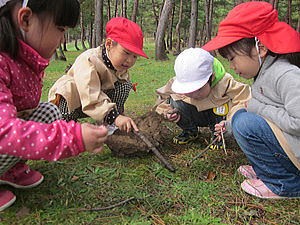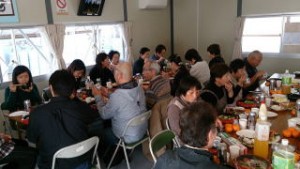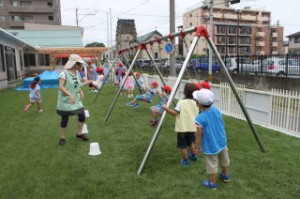Newsletter of the “NSKK No-Nuke Project” — Part II of the “Let’s Walk Together” Project,the Anglican-Episcopal Church in Japan’s efforts to “walk together” with victims of the Great East Japan Earthquake of March 2011
http://www.nskk.org/province/genpatsugroup/english
(Linked to the Provincial Office’s website)
“Issues and Repercussions of Nuclear Energy ” is Out as a pamphlet
Rev. Akira Iwaki,
Leader of the Research & Publicity Team,
“NSKK No-Nuke Project”
Soon after the Great East Japan Earthquake of March 2011, which made evident the dangers and issues of nuclear power plants (“NPPs” hereafter), most people thought NPPs should be abolished. We have, however, a saying, “Once on shore, pray no more.” Almost three years have passed since the Fukushima I meltdown began, and many outside Tohoku now seem to be amnesiac about NPPs’ dangers and issues – or they might be made to be. Today, TV, papers, and other mass media are carrying less serious news on NPPs than they did three years ago. Even in my church, I think we do not discuss or learn about NPPs frequently. Since many mass media almost ignore NPPs or report on NPPs to remain, I often hear people saying, “I don’t know what is happening with NPPs today.” Facing a situation like this, the “Project on Nuclear Power and Radiation” (part of the “Let’s Walk Together” Project Part II), a project of the Japan Province of the Anglican Communion, has issued a “nuclear catechism” titled “Qs & As on Nuclear Energy.” It is meant to share with parishes and their people truth on many aspects of nuclear energy – what is happening with NPPs, what NPPs really are, what makes them so deadly dangerous, if Japan’s economy will really collapse or not without NPPs, and many more. The “Qs & As” are now appearing in serial form in your Diocesan Reports and other publications. Don’t miss the series. In addition, we, the Project, are planning to add some more Qs and As to the “catechism” to make it a comprehensive pamphlet. When it appears, be sure to have some copies of it and keep them within your easy reach. Now, in Fukushima I, one shocking fact after another has been discovered with the contaminated water. The meltdown is still a serious threat to us. For instance, on February 21st, 2014, some 100 t of highly radioactive water leaked out of its tank and flew beyond the dam surrounding it. Fukushima I’s operator, TEPCO, ascribes it to some machine failures and human errors. We have witnessed a series of contaminated water leaks. They use some huge volume of cooling water to cool down the melting down reactors, but no one knows how to turn it into safe water. Also, the underground water vein running under the NPP’s site keeps flowing into the Pacific. Thus, the radioactive water leaks have been creating serious problems for many countries. How about the used nuclear fuels of Fukushima I? Though TEPCO has been and is removing such fuels out of Unit 4 and sinking them into the common pool, no human knows what to with those fuels after they cool down in the pool. This NPP has produced some gigantic amounts of used nuclear fuels and other highly radioactive wastes, and will produce more. What can we do with them? In spite of all those deadly issues, Japan’s government and power companies still hold on to NPPs as a “crucial source of power” and are trying to restart them. Worse yet, they are striving harder now to export made-in-Japan reactors Taiwan, Vietnam, India, Turkey, and others. For instance, the Fourth (Lungmen) Nuclear Power Plant of Taiwan, located in Gongliao District, New Taipei, has been supplied by Hitachi, Toshiba, and Mitsubishi Heavy Industries. This NPP’s building plan is some 30 years old now, yet the plant has yet to be completed, thanks to many accidents and powerful opposition from local residents. In many other countries as well, people’s voices against NPPs are growing stronger and stronger. We, the Project, plan to report on NPP situations outside Japan as well, in this newsletter. Nippon Sei Ko Kai (The Anglican-Episcopal Church in Japan, “NSKK” hereafter), at its 59th General Assembly, adopted the resolution named “In search of a world free from nuclear plants.” This resolution stands on faith that we must respect and cherish life, a creation of God. We hope each and every one of us will learn and live out the resolution.
To donate to us:
Postal transfer account with Japan Post: 00120-0-78536
Account holder: Nippon Sei Ko Kai (NSKK)
Please clearly state in the transfer slip “Donation to the NSKK NO-Nuke Project”
Message from the Support Team
In Fukushima, the serious contamination has not improved a bit. There still are numerous spots with high radioactivity.
Children there are still bound by many do’s and don’ts, in their everyday life. Adults, who have to tell them what to do and what not to do, are finding that very stressful. Those evacuees living in temporary houses are now experiencing the harsh winter of Tohoku (as of February 2014), for the third time after the meltdown began, amid fear of radiation and worries over their own future.
The Support Team conducted the activities below, with many thanks for your prayers.
[Refresh programs]
October 2013
Kids played around outdoors, to their heart’s content, in Inawashiro, far west in Fukushima Prefecture. (They cannot touch the earth in their own neighborhoods of eastern Fukushima.)
August 2013
Having fun with kids from Yamakoshi (formerly a municipality called Yamakoshi Village), Niigata Prefecture. (Children from east Fukushima and Yamakoshi had a joint summer camp in Sendai, Miyagi Prefecture.)
[Support to temporary house residents]
August 2013
Sunday school camp of St. Timothy’s Church, Onahama (At “Iwaki Shizen no Ie” [Nature House of Iwaki]) 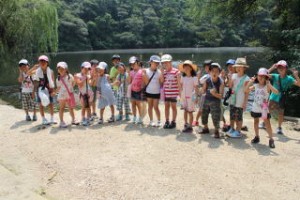
December 2013
We hold “Hokkori (Comfy) Café” four times a week (Shown above is a scene from a meal party at the Izumi-tomioka temporary housing.)
[Endless work of decontamination]
May 2013
Removing the topsoil to replace it with new soil (Shown above is the second replacement at the same place.) 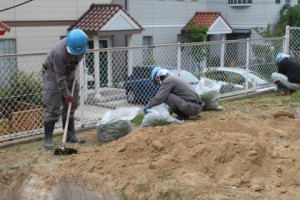
August 2013
Kids having fun in a kindergarten yard with artificial grass (The children above played outdoors for the first time in two years.)
Steering Committee of the “NSKK No-Nuke Project”
This committee was set up to the working principles of the “Let’s Walk Together” Project and the 2012 Resolution “In search of a world free from nuclear plants” of NSKK. Steering committee members: Revd. Kiyoshi Nomura (Chair), Revd. Akira Iwaki, Revd. Kenzo Koshiyama, Revd. Tazuru Sasamori, Ms. Hiroko Miyawaki Secretary General: Ms. Kay Ikezumi
2-9-23, Hayama, Koriyama City, Fukushima Prefecture
Phone: +81-249-53-5987
Another Q&A – How is TEPCO’s Fukushima 1 Today ?
In his yearning to host the 2020 Olympics, Japan’s Prime Minister Abe claimed that “the situation with the contaminated water (of Fukushima I) is under complete control.” On what ground, could he make such a claim??
The earthquake and tsunami of March 11th, 2011 hit Fukushima I and put it in a station blackout. The containment vessels’ cooling systems were unable to work, leading to the nuclear fuels’ meltdown. The buildings were blown up, and abundance of radioactive substances was scattered, to contaminate the atmosphere, the soil, and the ocean. Radioactive substances were detected in grain, beans, seafood, meat, milk, drink water, and others. This contamination is in no way confined within Fukushima Prefecture. Rather, the contamination has spread way beyond.
In response, Japan’s government has been striving hard to decontaminate some very large area. Yet so many mountains and so much of the ocean have been contaminated, and it has proven to be next to impossible to decontaminate such a vast area completely. Also, the decontamination work removed radioactive topsoil, but they cannot even find good places where they can store up such dangerous topsoil. What are they going to do with the topsoil in the future? No one knows.
Yet another deadly problem is the contaminated water leakage, which still persists all those months – thirty-five, as of February 2014 – after the meltdown began. To keep cool the nuclear fuels within the containments, they need some 370 t of cooling water everyday. To store used cooling water, which is contaminated, TEPCO has installed some hundreds of storage tanks in the premises of Fukushima I, with each storing 1,000 t of polluted water. In August 2003 for instance, however, some 300 t of highly contaminated water leaked out of one of those tanks. (As of February 2014,) they have yet to find out where the leakage took place. Some trenches surround the premises and some polluted water in such trenches carries radioactivity some 20 million times higher than the upper limit set by the Japanese government. Tritium, cesium, and other radioactive substances are leaking into the Pacific. The government, in its effort to prevent such deadly flows, is planning to build concrete walls to surround the whole NPP premises. Still, as of February 2014, they have yet to successfully confine radioactive substances.
Also note that all those “cooling and confinement” efforts expose countless laborers to deadly radioactivity. Japan’s Industrial Safety and Health Act holds 50 mSv a year as the upper limit of exposure for a NPP worker. Also, a single worker must not be exposed to anything above 100 mSv in accumulation over five years. In Fukushima I’s reality, however, countless workers are exceeding those upper limits, and the count is still on the rise. As a result, the NPP site is having fewer and fewer skilled workers available. This inevitably hampers the recovery work.
We are facing a gigantic heap of serious problems – contamination of some whole mountains and of the whole Pacific, stagnant decontamination work, sluggish work to control the meltdown, continuing exposure to small-dose radiation of residents in and around Fukushima, evacuees deprived of their hometowns whose families are torn apart, and —. And where are the clues to all these serious issues? Nowhere! In spite of all those tragedies, Japan’s government and business leaders are striving to restart the nation’s NPPs and even have decided to export a NPP to Turkey. Their sins are grave. And if we just let them get away such serious offenses, we too will be held accountable.
Sign of the Times – Column on Current Issues
On February 9th, 2014, Tokyo had its governor election. The winner by an overwhelming majority was Yoichi Masuzoe. Still, if we look into each candidate’s share of the vote, while Masuzoe won 43.3%, the two leading anti-nuke candidates, Morihoro Hosokawa and Kenji Utsunomiya, won 39.82% combined. In short, the difference between the two camps was very small. According to some reports, the essential difference between Hosokawa and Utsunomiya was that, while one of the two focused on NPP issues alone, the other covered other ones as well. Even the winner, Masuzoe, did not spoke out aloud “yes to nuclear.” Rather, he won the race resorting to other issues. In short, no candidate said an explicit “yes” to nukes. They acted to respond to the Tokyo voters’ will, and this is something the national government cannot ignore.
The Asahi Shimbun, a major newspaper of Japan, on October 31st, 2013, carried a column titled “Asu wo Saguru” (literally, “Searching for Tomorrow”). To it, Prof. Eiji Oguma of Keio University submitted an interesting thought, titled “Datsu-genpatsu Jitsugen-shitsutsu-aru Nippon.” (literally, “Japan Going Nuke-free”). Said the professor, “In effect, which country is getting rid of nuclear power? Needless to say, Japan. As of today, Japan has no NPP at work. And who has achieved this nuke-free situation? Did any politician take leadership to it? Did some wise bureaucrats planned for it? Some ‘external pressure’ from the US? None of these! The only truth is that its people are standing firm against nuclear power.” He also said, “The people’s demand to go nuke-free is gaining voltage,” and “This situation of no NPP in operation is now becoming an established state.”
Well, Prof. Oguma might sound too optimistic. Still, I do hope it is true that people’s hope can stop a “stampede” of the government, power companies, and NPP-related businesses. (Peter)
The world is on the move
– Towards freedom from nuclear power –
NSKK, at its 59th (regular) General Assembly held in May 2012, adopted a statement titled “In search of a world free from nuclear plants.” With this, the church group decided to oppose nuclear power, a major threat to life, as believers. The Roman Catholic Church of Japan, already in November 2011, called for an “immediate abolishment of NPPs” in its statement issued by the College of Bishops. Shortly before that, the Peace and Nuclear Issues Committee, National Christian Council (NCC) in Japan, issued a statement titled, “Datsu-genpatsu seisaku wo jitsugenshi, mata kaku no yushutsu wo sugu yametekudasai” (literally, “Take measures to go free from nuclear power, and stop nuclear exports immediately”). Those moves were followed by many other church groups, with all their different nuances, who are determined opponents to nuclear power. They include, among many others: Japan Baptist Convention, Japan Evangelical Lutheran Church, Japan Baptist Union, and Japan Alliance Christ Church.
Japan is not alone. Countless churches all over the world are moving in the same direction. For instance, in Germany, which as a nation has determined to go nuke-free, many churches are promoting renewable energies and independence from nuclear energy, in their everyday activities of evangelization. In December 2012, the NCC in Japan and others hosted, in Aizu Wakamatsu, Fukushima, the Inter-religious Conference on Nuclear Issues. One participant in the Conference from Germany’s Lutheran Church, Environment Protection Commissionerof the Protestant Church of Baden, Dr. André Witthöft-Mühlmann, spoke about specific activities in his country. This conference also had participants from churches of South Korea, the United Methodist Church of the US, the Episcopal Church in the Philippines, the Angliccan/Episcopal Church in Japan, as well as many from the Buddhist faith. They spoke up from their own respective standpoints. The conference, to conclude, adopted the “No to Nuclear Power! Faith Declaration from Fukushima 2012,” and decided to work on the World Council of Churches (WCC) to consider the Declaration in its 10th Assembly, to convene in Busan, South Korea, in October 2013.
Also emerging is cross-border solidarity among citizens’ movements. In 2013, some young ones of NSKK visited NPPs in South Korea to have fellowship with local young people. Currently, the nation has 32 reactors in four NPPs. In October 2013, some Christians and citizen group members from those NPP locations, carrying on anti-nuke activities, visited Japan to build up ties with their Japanese counterparts in Genkai, Ikata, Kaminoseki, Fukui ( All these are NPP locations.), as well as in Osaka, Fukushima, etc. To conclude this visit, they held a farewell meeting in Kobe, where Revd. Lee Dae Su and others reported on what was going on in South Korea. Then, there was a tour to visit all the four NPPs of the nation from Japan. Furthermore, anti-nukes of Japan are now collaborating with their counterparts in Taiwan, Indonesia, the Philippines, Canada, Germany, the US, Cuba, etc. Especially notable is Taiwan, whose “NPP No. 4 (Lungmen)” is actually an import from Japan and often known as “Hinomaru NPP” (NPP with Japan’s national flag). Many locals are opposed to it. Among them, the Presbyterian Church is one of the determined opponents to NPPs.
Those citizen groups sent their representatives to the WCC Assembly in Busan as well, to make their achievements known to the world. Thus, anti-nuke solidarity across national borders is now quite active and expanding.
At the Busan Assembly of the WCC, more than 5,000 participants gathered from Asia, Middle East, Europe, Africa, North America, the Caribbean, Latin America, and the Pacific. They discussed, not just issues the Christendom is facing, but many other important problems involving peace and justice, including those related to nuclear energy. However, I am afraid, the Assembly failed to reach a resolution on nuclear power issues, after serious discussions. WCC’s Central Committee should continue the discussions on nuclear power, when they convene in 2014. I believe they will come up with some good resolutions (Rev. Akira Iwaki)
To donate to us:
◆Postal transfer account with Japan Post: 00120-0-78536
Account holder: Nippon Sei Ko Kai (NSKK)
Please clearly state in the transfer slip “Donation to the Project on Nuclear Power and Radiation”
Or:
◆Account Name;NIPPON SEI KO KAI
◆Address;
65 Yarai-cho, Shinjuku-ku,
Tokyo 162-0805 JAPAN
◆Account Number;4515547
◆Bank Name;The Bank of Tokyo-Mitsubishi UFJ, LTD.
Branch Name;Iidabashi
◆Bank Address;
3-7 Kagurazaka, Shinjuku-ku,
Tokyo 162-0825 JAPAN
Contact:
NSKK No-Nuke Project
Let us Walk Together Project Part II
NSKK Support for Victims of the Great Eastern Japan Earthquake
Kohriyama St.Peter & St. Paul Church
2-9-23, Hayama, Kohriyama City
Fukushima Prefecture
Japan
Tel: 81-24-953-5987
http://nskk.org/province/genpatsugroup
ikezumi-nyc.chubu@nskk.org
genpatsugroup@gmail.com


